The Role of Atmospheric Circulation in Favouring Forest Fires in the Extreme Southern Portugal
Abstract
1. Introduction
2. Materials and Methods
2.1. Study Region and Case Studies
2.2. Synoptic Data
2.3. Weather Stations Data
2.4. Numerical Modelling
2.4.1. Numerical Experiments
2.4.2. Model Verification
3. Results
3.1. Tavira Fire (TAV-Fire), 18–20 July 2012
3.1.1. Large-Scale Conditions
3.1.2. Mesoscale Environment
3.2. Aljezur Fire (ALJ-Fire), 19–21 June 2020
3.2.1. Large-Scale Conditions
3.2.2. Mesoscale Environment
4. Discussion
5. Conclusions
Author Contributions
Funding
Institutional Review Board Statement
Informed Consent Statement
Data Availability Statement
Acknowledgments
Conflicts of Interest
Appendix A. Model Verification
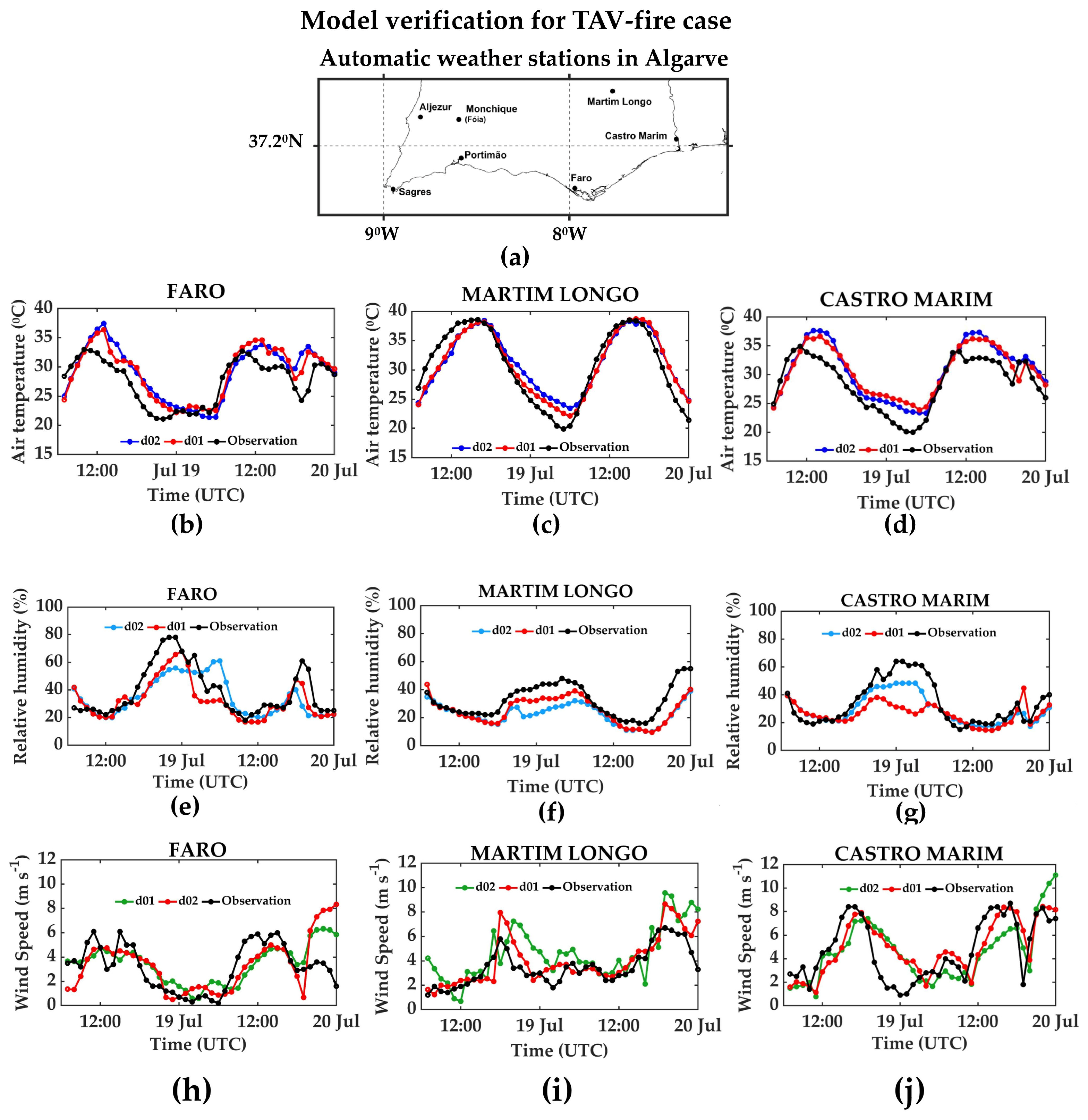
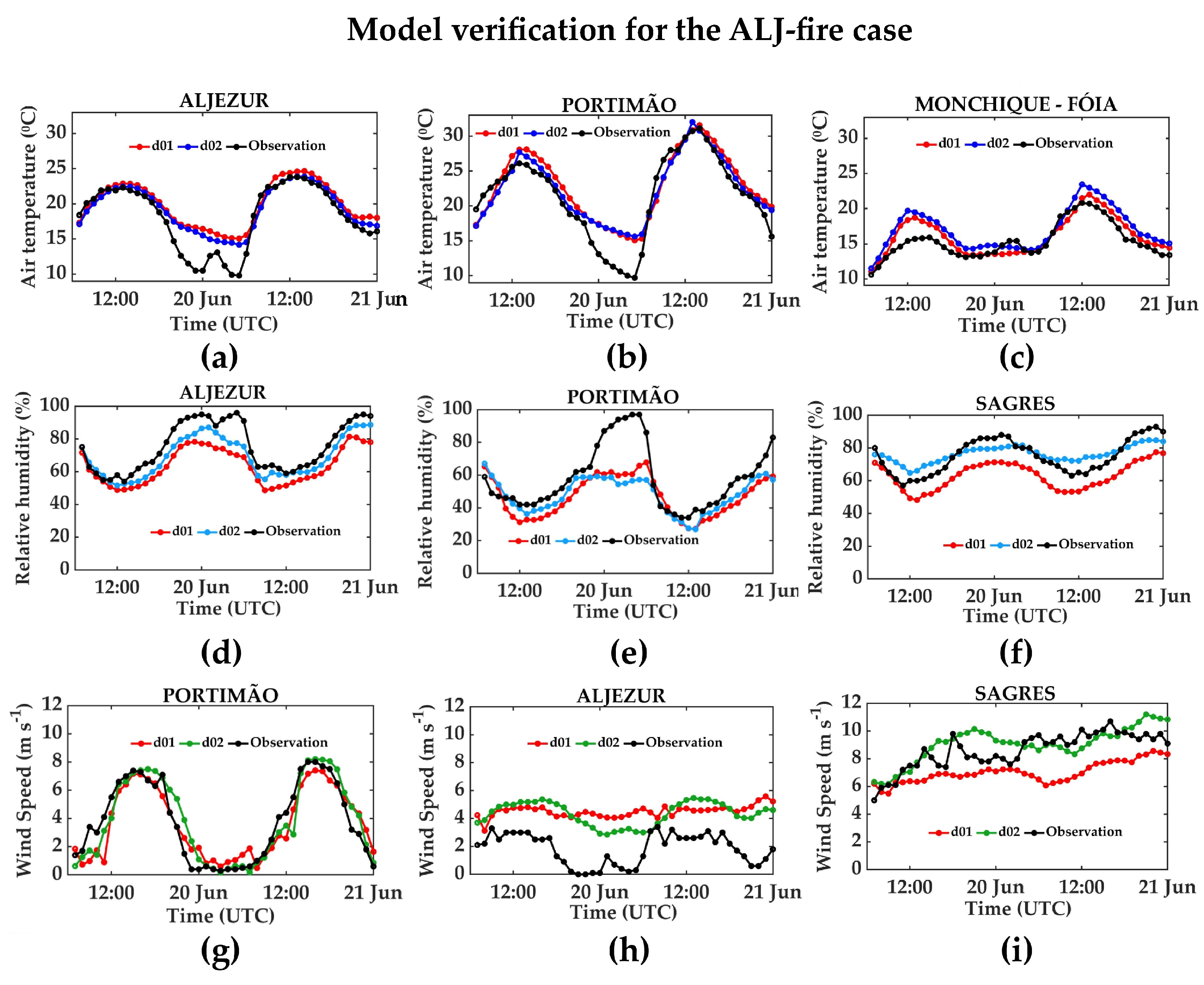
References
- Fromm, M.; Lindsey, D.T.; Servranckx, R.; Yue, G.; Trickl, T.; Sica, R.; Doucet, P.; Godin-Beekmann, S. The Untold Story of Pyrocumulonimbus. Bull. Am. Meteorol. Soc. 2010, 91, 1193–1210. [Google Scholar] [CrossRef]
- Peace, M.; Ye, H.; Greenslade, J.; Kepert, J.D. The Destructive Sir Ivan Fire in New South Wales, Australia; Simulations Using a Coupled Fire—Atmosphere Model. Fire 2023, 6, 438. [Google Scholar] [CrossRef]
- Couto, F.T.; Filippi, J.-B.; Baggio, R.; Campos, C.; Salgado, R. Triggering Pyro-Convection in a High-Resolution Coupled Fire–Atmosphere Simulation. Fire J. 2024, 7, 92. [Google Scholar] [CrossRef]
- Raphael, M.N. The Santa Ana Winds of California. Earth Interact. 2003, 7, 1–13. [Google Scholar] [CrossRef]
- Brewer, M.J.; Clements, C.B. The 2018 Camp Fire: Meteorological Analysis Using in Situ Observations and Numerical Simulations. Atmosphere 2020, 11, 47. [Google Scholar] [CrossRef]
- Coen, J.L.; Schroeder, W. The High Park Fire: Coupled Weather-Wildland Fire Model Simulation of a Windstorm-Driven Wildfire in Colorado’s Front Range. J. Geophys. Res. Atmos. 2015, 120, 131–146. [Google Scholar] [CrossRef]
- Coen, J.L.; Schroeder, W.; Quayle, B. The Generation and Forecast of Extreme Winds during the Origin and Progression of the 2017 Tubbs Fire. Atmosphere 2018, 9, 462. [Google Scholar] [CrossRef]
- Kartsios, S.; Karacostas, T.; Pytharoulis, I.; Dimitrakopoulos, A.P. Numerical Investigation of Atmosphere-Fire Interactions during High-Impact Wildland Fire Events in Greece. Atmos. Res. 2021, 247, 105253. [Google Scholar] [CrossRef]
- Čavlina Tomašević, I.; Cheung, K.K.W.; Vučetić, V.; Fox-Hughes, P. Comparison of Wildfire Meteorology and Climate at the Adriatic Coast and Southeast Australia. Atmosphere 2022, 13, 755. [Google Scholar] [CrossRef]
- Čavlina Tomašević, I.; Vučetić, V.; Cheung, K.K.W.; Fox-Hughes, P.; Beggs, P.J.; Telišman Prtenjak, M.; Malečić, B. Comparison of Meteorological Drivers of Two Large Coastal Slope-Land Wildfire Events in Croatia and South-East Australia. Atmosphere 2023, 14, 1076. [Google Scholar] [CrossRef]
- Koulelis, P.P.; Proutsos, N.; Solomou, A.D.; Avramidou, E.V.; Malliarou, E.; Athanasiou, M.; Xanthopoulos, G.; Petrakis, P.V. Effects of Climate Change on Greek Forests: A Review. Atmosphere 2023, 14, 1155. [Google Scholar] [CrossRef]
- Tomshin, O.; Solovyev, V. Synoptic Weather Patterns during Fire Spread Events in Siberia. Sci. Total Environ. 2024, 921, 171205. [Google Scholar] [CrossRef]
- Papavasileiou, G.; Giannaros, T.M. Synoptic-Scale Drivers of Fire Weather in Greece. Sci. Total Environ. 2024, 925, 171715. [Google Scholar] [CrossRef] [PubMed]
- Sharples, J.J. An Overview of Mountain Meteorological Effects Relevant to Fire Behaviour and Bushfire Risk. Int. J. Wildland Fire 2009, 18, 737. [Google Scholar] [CrossRef]
- Čavlina Tomašević, I.; Cheung, K.K.W.; Vučetić, V.; Fox-Hughes, P.; Horvath, K.; Telišman Prtenjak, M.; Beggs, P.J.; Malečić, B.; Milić, V. The 2017 Split Wildfire in Croatia: Evolution and the Role of Meteorological Conditions. Nat. Hazards Earth Syst. Sci. 2022, 22, 3143–3165. [Google Scholar] [CrossRef]
- Fox-Hughes, P. Synoptic and Mesoscale Aspects of Exceptional Fire Weather during the New Year Period 2019–20 in Southeastern New South Wales, Australia. Weather. Forecast. 2023, 38, 2237–2252. [Google Scholar] [CrossRef]
- Russell, E.N.; Loikith, P.C.; Ajibade, I.; Done, J.M.; Lower, C. The Meteorology and Impacts of the September 2020 Western United States Extreme Weather Event. Weather. Clim. Extrem. 2024, 43, 100647. [Google Scholar] [CrossRef]
- Purificação, C.; Andrade, N.; Potes, M.; Salgueiro, V.; Couto, F.T.; Salgado, R. Modelling the Atmospheric Environment Associated with a Wind-Driven Fire Event in Portugal. Atmosphere 2022, 13, 1124. [Google Scholar] [CrossRef]
- Couto, F.T.; Salgado, R.; Guiomar, N. Forest Fires in Madeira Island and the Fire Weather Created by Orographic Effects. Atmosphere 2021, 12, 827. [Google Scholar] [CrossRef]
- Belo-Pereira, M.; Santos, J.A. Air-Traffic Restrictions at the Madeira International Airport due to Adverse Winds: Links to Synoptic-Scale Patterns and Orographic Effects. Atmosphere 2020, 11, 1257. [Google Scholar] [CrossRef]
- Couto, F.T.; Santos, F.L.M.; Campos, C.; Andrade, N.; Purificação, C.; Salgado, R. Is Portugal Starting to Burn All Year Long? The Transboundary Fire in January 2022. Atmosphere 2022, 13, 1677. [Google Scholar] [CrossRef]
- Kolden, C.A.; Abatzoglou, J.T. Spatial Distribution of Wildfires Ignited under Katabatic versus Non-Katabatic Winds in Mediterranean Southern California USA. Fire 2018, 1, 19. [Google Scholar] [CrossRef]
- Purificação, C.; Campos, C.; Henkes, A.; Couto, F.T. Exploring the Atmospheric Conditions Increasing Fire Danger in the Iberian Peninsula. Q. J. R. Meteorol. Soc. 2024, 1–20. [Google Scholar] [CrossRef]
- Andrade, N.; Couto, F.T.; Serra, J. Assessing Fire Risk Perception in the Vale Do Guadiana Natural Park, Portugal. Fire 2023, 6, 243. [Google Scholar] [CrossRef]
- VisitAlgarve. Available online: https://visitalgarve.pt/3504/demografia-e-geografia (accessed on 25 May 2024).
- Gabinete Técnico Florestal Inter-Municipal de Aljezur, Lagos e Vila do Bispo. Plano Inter-Municipal de Defesa da Floresta Contra Incêndios de Aljezur, Lagos E Vila Do Bispo 2016–2020. Available online: https://www.cm-lagos.pt/images/site/cliente/CADERNO_I_TERRAS_INFANTE.pdf (accessed on 20 March 2024).
- Comissão Municipal de Defesa da Floresta Contra Incêndios de Monchique. Plano Municipal de Defesa da Floresta Contra Incêndios. 2022. Available online: http://fogos.icnf.pt/pmdfci/08_Faro/0809/2G/Caderno_I/Texto/PMDFCI_Monchique_Caderno_I.pdf (accessed on 20 March 2024).
- Serra do Caldeirão. Guia da Cidade. Available online: https://www.guiadacidade.pt/pt/poi-serra-do-caldeirao-17391 (accessed on 25 May 2024).
- Feio, M. A evolução—Do relevo do Baixo Alentejo e Algarve, Laboratório Nacional de Energia e Geologia, Lisboa, 1952. Available online: https://docbase.lneg.pt/docs/Comunicacoes/communicacoes32_algarve.pdf (accessed on 3 July 2024).
- Oliveira, P. Considerações Sobre O Clima Do Algarve; Governo de Portugal, Ministério da Agricultura, Do Mar, Do Ambiente e do Ordenamento do Território: Algarve, 2018. Available online: https://www.drapalgarve.gov.pt/ema/images/artigos/DRAPALG%20EMAs%20-%20clima%20no%20Algarve.pdf (accessed on 12 May 2024).
- Pedras, C.; Silva, E.; Martins, F.; Fernandez, H.; Lourenço, L.; Lança, R. Incêndio Catraia (Tavira) Livro Guia da Visita Técnica (6 de Novembro de 2015), RISCOS—Associação Portuguesa de Riscos, Prevenção e Segurança, 2015. Available online: https://www.riscos.pt/wp-content/uploads/2018/Outras_Pub/guias/Livro_Visita_Tecnica_Catraia.pdf (accessed on 22 September 2023).
- Florestas.pt. Floresta em Portugal Continental, Região a Região—Florestas.pt. Florestas.pt. Available online: https://florestas.pt/conhecer/floresta-em-portugal-continental-regiao-a-regiao/ (accessed on 15 May 2024).
- Vila-Viçosa, C.; Arsénio, P. Vegetação Do Sudoeste Português. In A Vegetação de Portugal; Impresa Nacional: Lisboa, Portugal, 2021. [Google Scholar]
- Viegas, D.X.; Figueiredo, A.R.; Almeida, M.A.; Reva, V.; Ribeiro, L.M.; Viegas, M.T.; Oliveira, R.; Raposo, J.R. Relatório Do Incêndio Florestal de Tavira/São Brás de Alportel; Ministério da Administração Interna, 2012. Available online: https://www.historico.portugal.gov.pt/media/730414/rel_incendio_florestal_tavira_jul2012.pdf (accessed on 22 September 2023).
- ICNF, I.P. Relatório de Estabilização de Emergência do Incêndio da Vilarinha de Junho de 2020; ICNF, I.P, Direção Regional da Conservação da Natureza e Florestas do Algarve, 2020. Available online: https://fogos.icnf.pt/download/REE/2020_001/REE_2020_001.pdf (accessed on 13 March 2023).
- Setchell, H. Operational Archive. ECMWF. Available online: https://www.ecmwf.int/en/forecasts/dataset/operational-archive (accessed on 25 May 2024).
- Kartsios, S.; Pytharoulis, I.; Karacostas, T.; Pavlidis, V.; Katragkou, E. Verification of a global weather forecasting system for decision-making in farming over Africa. Acta Geophys. 2024, 72, 467–488. [Google Scholar] [CrossRef]
- Lac, C.; Chaboureau, J.-P.; Masson, V.; Pinty, J.-P.; Tulet, P.; Escobar, J.; Leriche, M.; Barthe, C.; Aouizerats, B.; Augros, C.; et al. Overview of the Meso-NH Model Version 5.4 and Its Applications. Geosci. Model. Dev. 2018, 11, 1929–1969. [Google Scholar] [CrossRef]
- Pergaud, J.; Masson, V.; Malardel, S.; Couvreux, F. A Parameterization of Dry Thermals and Shallow Cumuli for Mesoscale Numerical Weather Prediction. Bound Lay. Meteorol. 2009, 132, 83–106. [Google Scholar] [CrossRef]
- Pinty, J.-P.; Jabouille, P. A Mixed-Phase Cloud Parameterization for Use in a Mesoscale Non-Hydrostatic Model: Simulations of a Squall Line and of Orographic Precipitation. In Proceedings of the Conference of Cloud Physics, Everett, WA, USA, 17–21 August 1998. [Google Scholar]
- Mlawer, E.J.; Taubman, S.J.; Brown, P.D.; Iacono, M.J.; Clough, S.A. Radiative Transfer for Inhomogeneous Atmospheres: RRTM, a Validated Correlated-k Model for the Longwave. J. Geophys. Res. Atmos. 1997, 102, 16663–16682. [Google Scholar] [CrossRef]
- Cuxart, J.; Bougeault, P.; Redelsperger, J.-L. A Turbulence Scheme Allowing for Mesoscale and Large-Eddy Simulations. Q. J. R. Meteorol. Soc. 2000, 126, 1–30. [Google Scholar] [CrossRef]
- Verrelle, A.; Ricard, D.; Lac, C. Sensitivity of High-Resolution Idealized Simulations of Thunderstorms to Horizontal Resolution and Turbulence Parametrization. Q. J. R. Meteorol. Soc. 2014, 141, 433–448. [Google Scholar] [CrossRef]
- Masson, V.; Le Moigne, P.; Martin, E.; Faroux, S.; Alias, A.; Alkama, R.; Belamari, S.; Barbu, A.; Boone, A.; Bouyssel, F.; et al. The SURFEXv7.2 Land and Ocean Surface Platform for Coupled or Offline Simulation of Earth Surface Variables and Fluxes. Geosci. Model. Dev. 2013, 6, 929–960. [Google Scholar] [CrossRef]
- LP DAAC. NASA Shuttle Radar Topography Mission (SRTM), Version 3.0 (SRTM Plus) Product Release; Learn about the Land Processes Distributed Active Archive Center. Available online: https://lpdaac.usgs.gov/news/nasa-shuttle-radar-topography-mission-srtm-version-30-srtm-plus-product-release/ (accessed on 30 April 2023).
- Faroux, S.; Kaptué Tchuenté, A.T.; Roujean, J.-L.; Masson, V.; Martin, E.; Le Moigne, P. ECOCLIMAP-II/Europe: A Twofold Database of Ecosystems and Surface Parameters at 1 km Resolution Based on Satellite Information for Use in Land Surface, Meteorological and Climate Models. Geosci. Model. Dev. 2013, 6, 563–582. [Google Scholar] [CrossRef]
- Poggio, L.; de Sousa, L.M.; Batjes, N.H.; Heuvelink, G.B.M.; Kempen, B.; Ribeiro, E.; Rossiter, D. SoilGrids 2.0: Producing Soil Information for the Globe with Quantified Spatial Uncertainty. Soil 2021, 7, 217–240. [Google Scholar] [CrossRef]
- Hoinka, K.-P.; de Castro, M. The Iberian Peninsula Thermal Low. Q. J. R. Meteorol. Soc. 2003, 129, 1491–1511. [Google Scholar] [CrossRef]
- Miranda, P.M.A. Introdução à Meteorologia, IDL, Faculdade de Ciências, Universidade de Lisboa; IPMA: Lisbon, Portugal, 2017. [Google Scholar]
- Soares, P.M.M.; Cardoso, R.M.; Semedo, Á.; Chinita, M.J.; Ranjha, R. Climatology of the Iberia Coastal Low-Level Wind Jet: Weather Research Forecasting Model High-Resolution Results. Tellus A 2014, 66, 22377. [Google Scholar] [CrossRef][Green Version]
- Cardoso, R.M.; Soares, P.M.M.; Lima, D.C.A.; Semedo, A. The Impact of Climate Change on the Iberian Low-Level Wind Jet: EURO-CORDEX Regional Climate Simulation. Tellus A 2016, 68, 29005. [Google Scholar] [CrossRef]
- Lima, D.C.A.; Soares, P.M.M.; Semedo, A.; Cardoso, R.M. A Global View of Coastal Low-Level Wind Jets Using an Ensemble of Reanalyses. J. Clim. 2018, 31, 1525–1546. [Google Scholar] [CrossRef]
- Lima, D.C.A.; Soares, P.M.M.; Nogueira, M.; Semedo, A. Global Coastal Low-Level Wind Jets Revisited through the New ERA5 Reanalysis. Int. J. Climatol. 2021, 42, 4491–4507. [Google Scholar] [CrossRef]
- Davis, R.E.; Hayden, B.P.; Gay, D.A.; Phillips, W.L.; Jones, G.V. The North Atlantic Subtropical Anticyclone. J. Clim. 1997, 10, 728–744. [Google Scholar] [CrossRef]
- IPMA—Monitorização da Seca Meteorológica. IPMA. Available online: https://www.ipma.pt/pt/oclima/observatorio.secas (accessed on 25 May 2024).
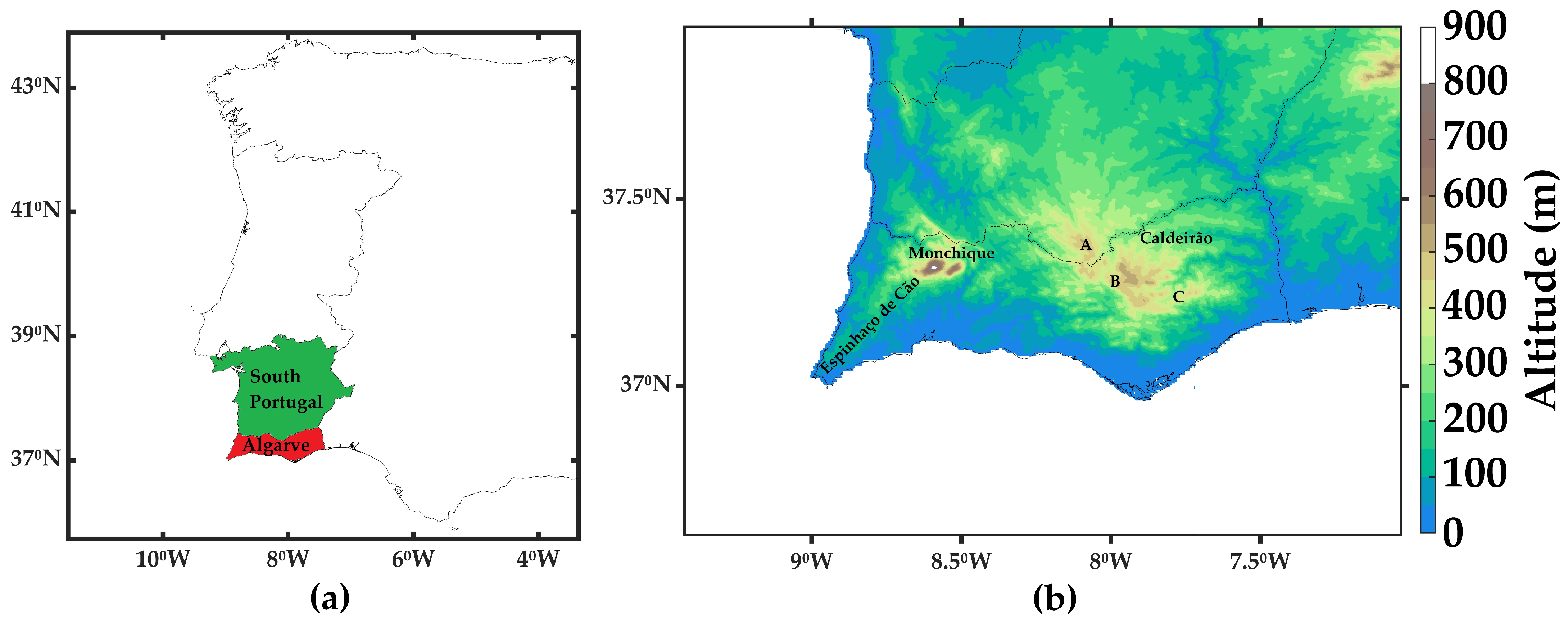
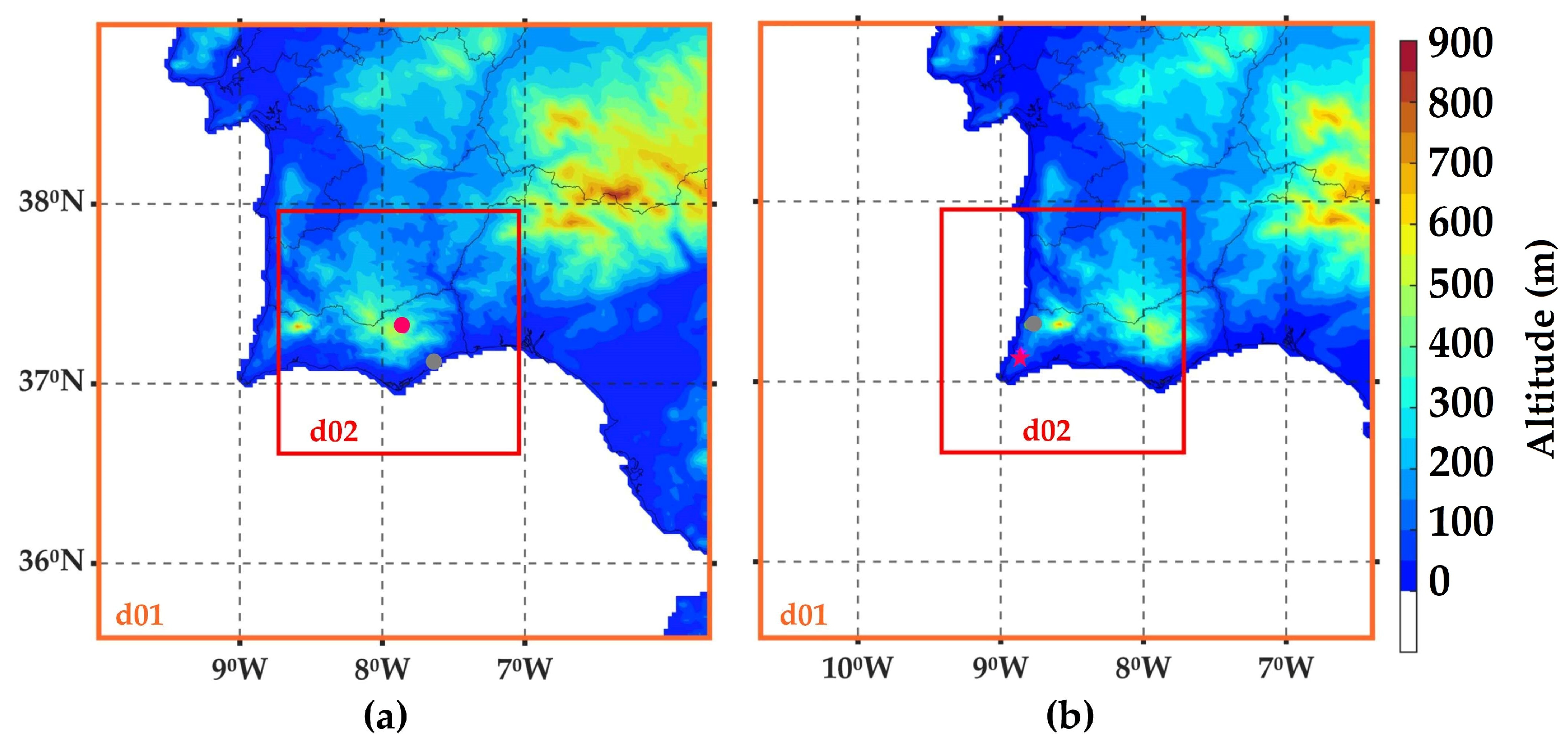

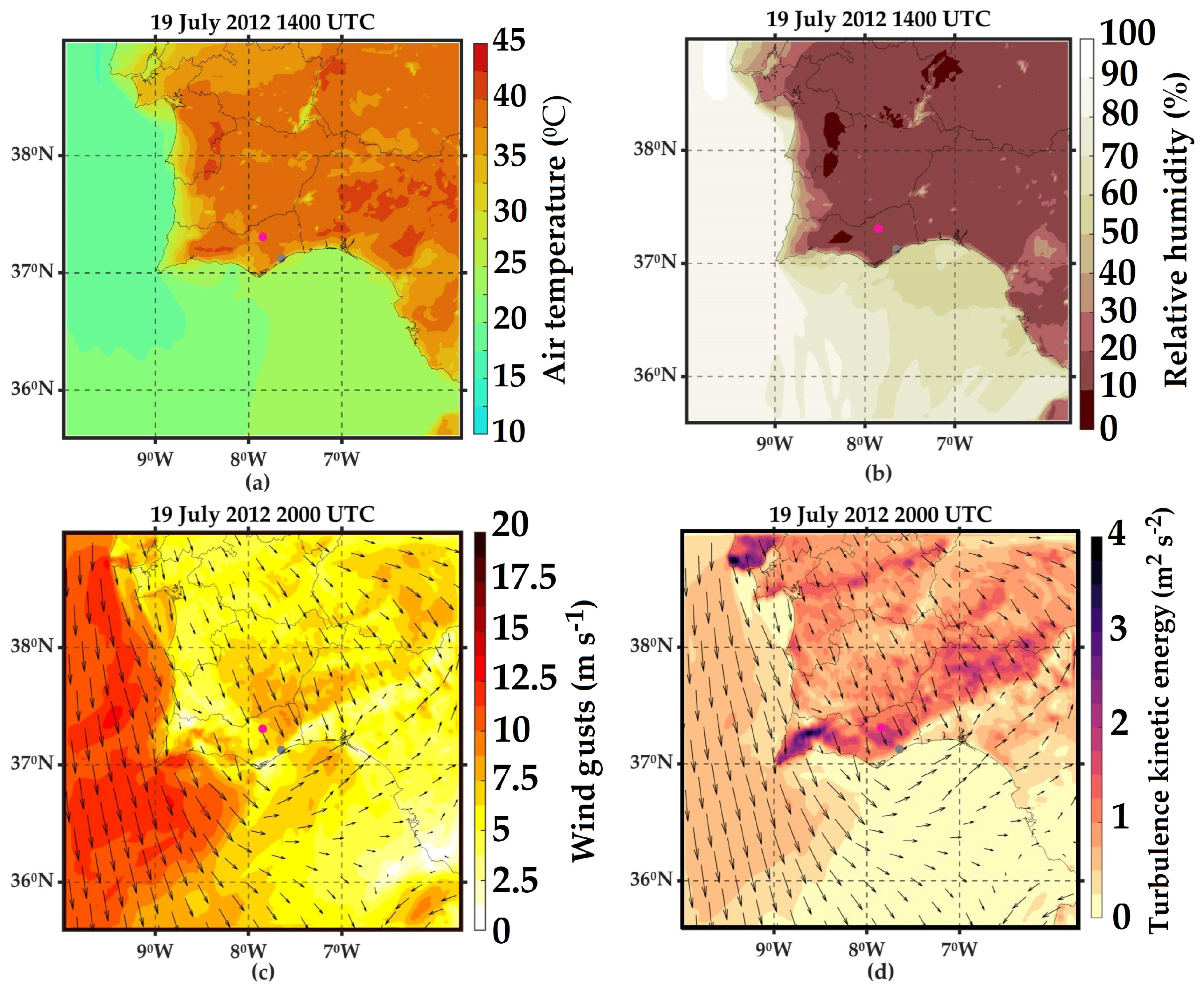
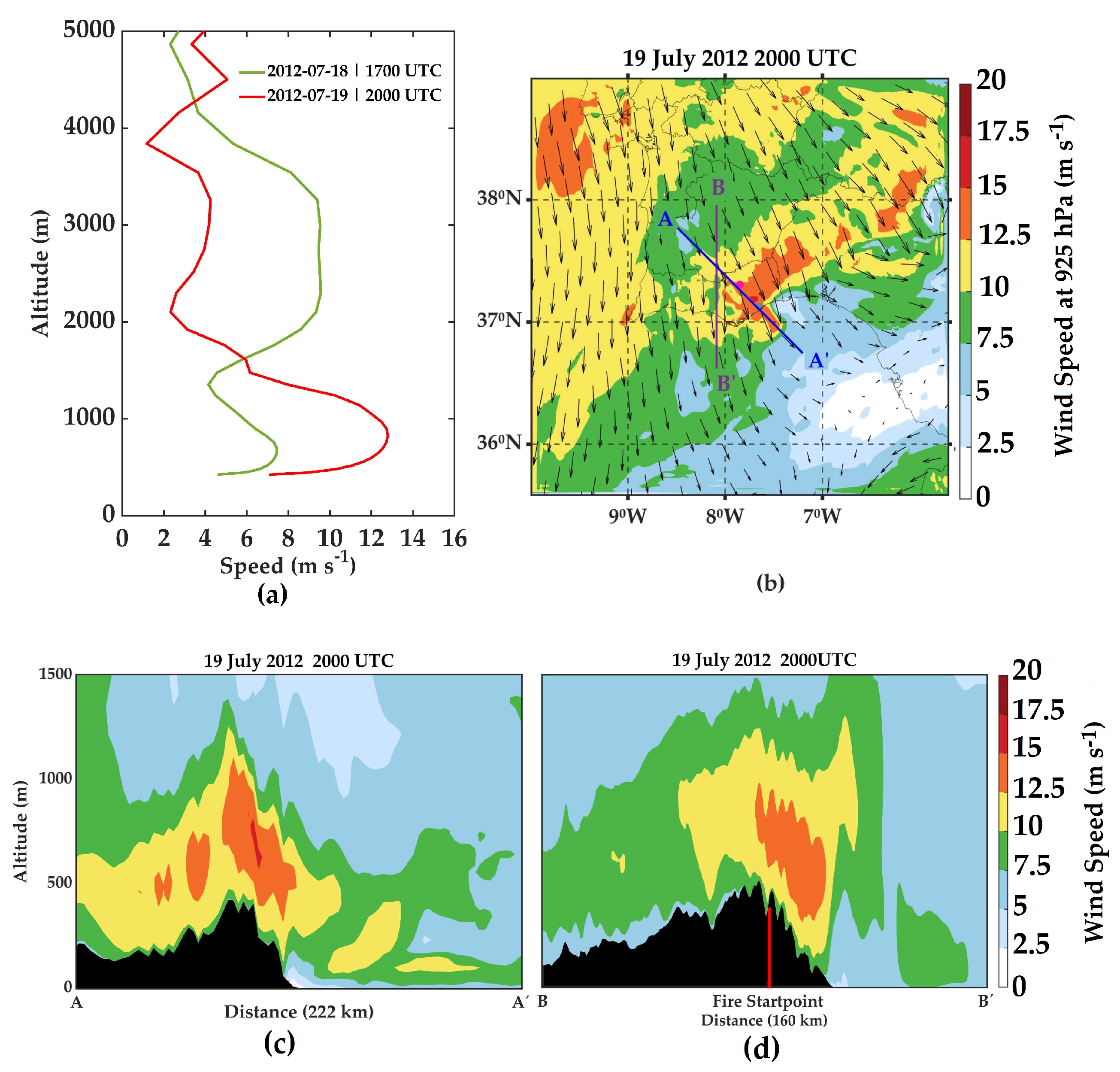
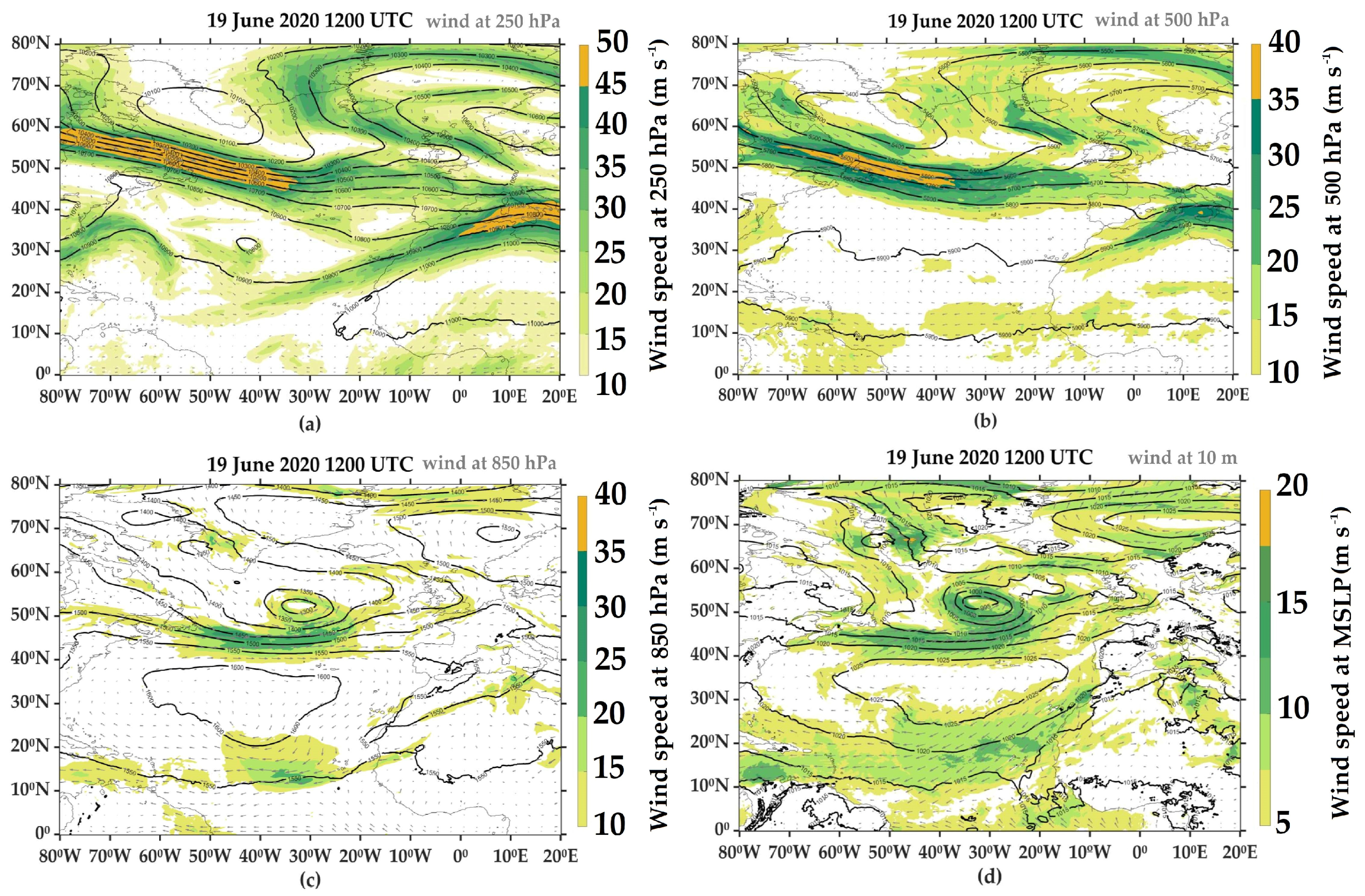
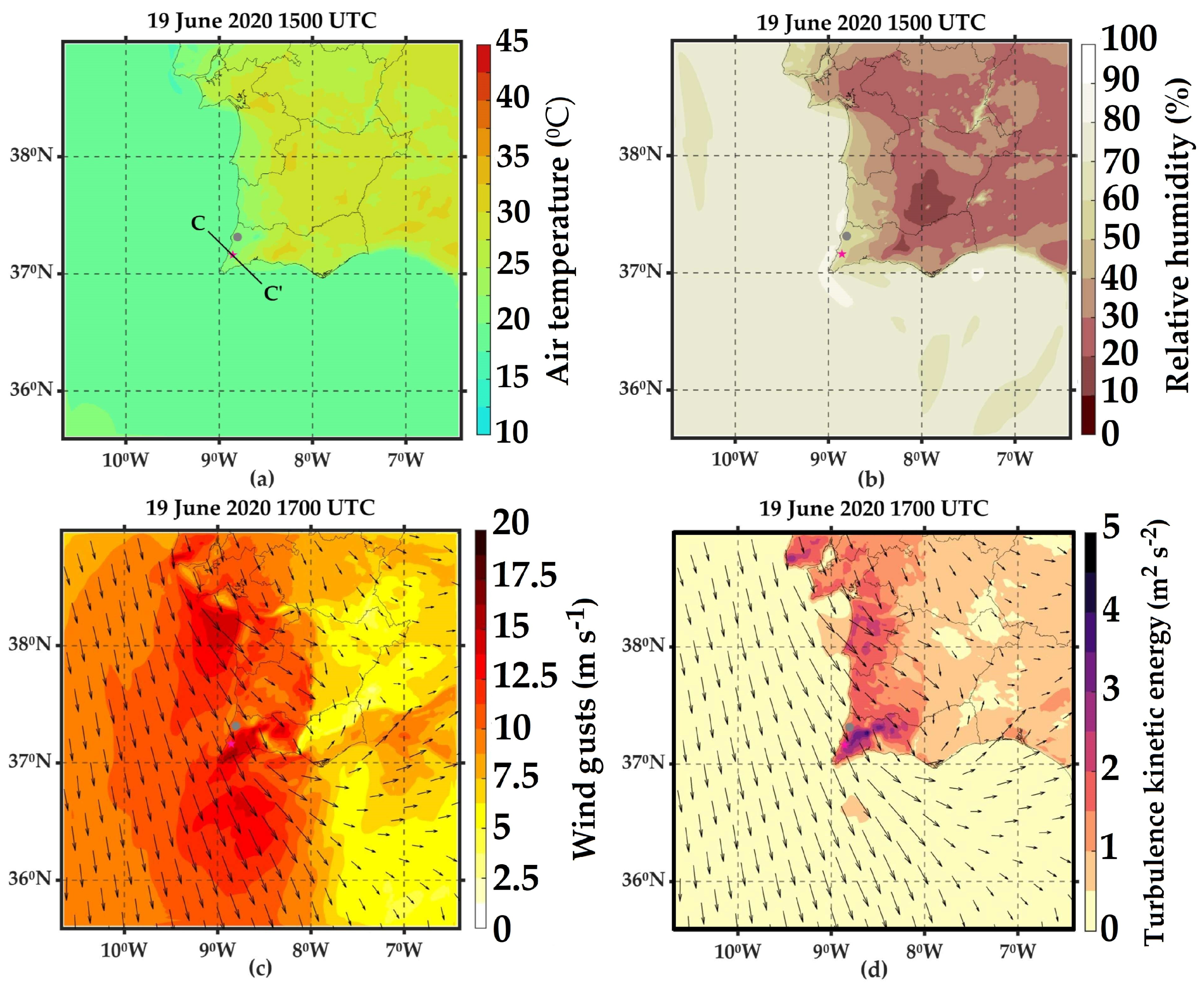

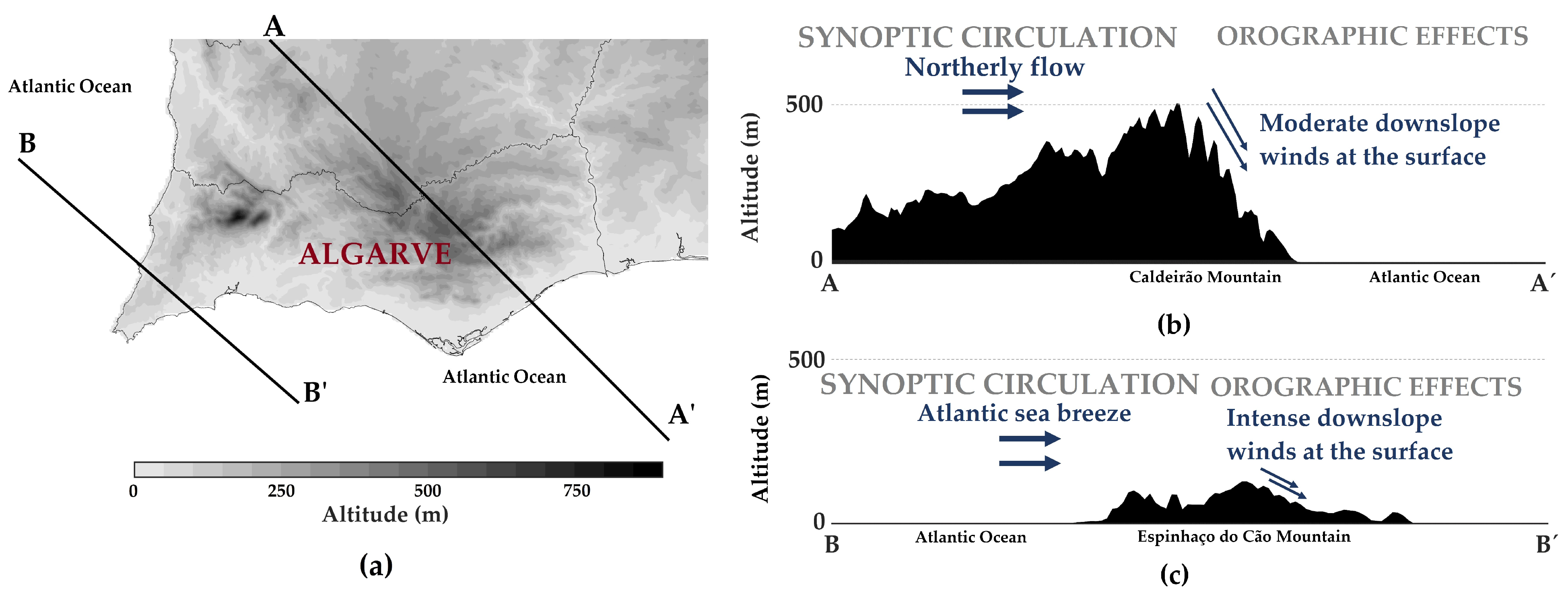
| EXP1 and EXP2 | ||
|---|---|---|
| Parametrisation | 2500 m | 500 m |
| Turbulence | 1D | 3D |
| Convection | None | None |
| Shallow convection | EDKF | None |
| Cloud microphysics | ICE3 | ICE3 |
| Radiation | ECMWF | ECMWF |
| Variable | Station | ME | RMSE |
|---|---|---|---|
| T2M | Faro | 4.2 | 4.2 |
| Martim Longo | −3.2 | 4.3 | |
| Castro Marim | 0.9 | 3.0 | |
| RH2M | Faro | −6.7 | 8.7 |
| Martim Longo | −4.1 | 5.4 | |
| WIND | Castro Marim | −1.8 | 3.4 |
| Faro | −0.6 | 1.4 | |
| Martim Longo | −0.9 | 1.4 | |
| Castro Marim | −1.2 | 1.6 |
| Variable | Station | ME | RMSE |
|---|---|---|---|
| T2M | Aljezur | 0.7 | 0.7 |
| Monchique (Fóia) | 3.1 | 3.2 | |
| Portimão | 0.5 | 0.98 | |
| RH2M | Sagres | 4.4 | 5.1 |
| Aljezur | −7.3 | 7.3 | |
| Portimão | −5.0 | 5.4 | |
| WIND | Sagres | −0.05 | 0.5 |
| Aljezur | 2.8 | 2.9 | |
| Portimão | −0.2 | 1.0 |
Disclaimer/Publisher’s Note: The statements, opinions and data contained in all publications are solely those of the individual author(s) and contributor(s) and not of MDPI and/or the editor(s). MDPI and/or the editor(s) disclaim responsibility for any injury to people or property resulting from any ideas, methods, instructions or products referred to in the content. |
© 2024 by the authors. Licensee MDPI, Basel, Switzerland. This article is an open access article distributed under the terms and conditions of the Creative Commons Attribution (CC BY) license (https://creativecommons.org/licenses/by/4.0/).
Share and Cite
Purificação, C.; Henkes, A.; Kartsios, S.; Couto, F.T. The Role of Atmospheric Circulation in Favouring Forest Fires in the Extreme Southern Portugal. Sustainability 2024, 16, 6985. https://doi.org/10.3390/su16166985
Purificação C, Henkes A, Kartsios S, Couto FT. The Role of Atmospheric Circulation in Favouring Forest Fires in the Extreme Southern Portugal. Sustainability. 2024; 16(16):6985. https://doi.org/10.3390/su16166985
Chicago/Turabian StylePurificação, Carolina, Alice Henkes, Stergios Kartsios, and Flavio Tiago Couto. 2024. "The Role of Atmospheric Circulation in Favouring Forest Fires in the Extreme Southern Portugal" Sustainability 16, no. 16: 6985. https://doi.org/10.3390/su16166985
APA StylePurificação, C., Henkes, A., Kartsios, S., & Couto, F. T. (2024). The Role of Atmospheric Circulation in Favouring Forest Fires in the Extreme Southern Portugal. Sustainability, 16(16), 6985. https://doi.org/10.3390/su16166985









